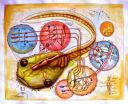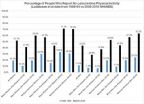(Press-News.org) WASHINGTON, July 7, 2014 — The World Cup final is almost here, and no matter which two teams meet for the title match, there's one thing they'll both need to win: the ball. This week, Reactions examines the chemistry that goes into making the "brazuca," and what makes it different from most other soccer balls out there. The video is available at https://www.youtube.com/watch?v=1XNTfslUzt8.
INFORMATION:
Subscribe to the series at Reactions YouTube, and follow us on Twitter @ACSreactions to be the first to see our latest videos.
The American Chemical Society is a nonprofit organization chartered by the U.S. Congress. With more than 161,000 members, ACS is the world's largest scientific society and a global leader in providing access to chemistry-related research through its multiple databases, peer-reviewed journals and scientific conferences. Its main offices are in Washington, D.C., and Columbus, Ohio.
To automatically receive news releases from the American Chemical Society, contact newsroom@acs.org.
Follow us: Twitter Facebook
World Cup chemistry: The science behind the 'brazuca' (video)
2014-07-07
ELSE PRESS RELEASES FROM THIS DATE:
Infant toenails reveal in utero exposure to low-level arsenic, Dartmouth study finds
2014-07-07
Infant toenails are a reliable way to estimate arsenic exposure before birth, a Dartmouth College study shows.
The findings appear in the Journal of Exposure Science & Environmental Epidemiology. A PDF of the study is available on request.
A growing body of evidence suggests that in utero and early-life exposure to arsenic may have detrimental effects on children, even at the low to moderate levels common in the United States and elsewhere. The fetus starts to develop toenails during the first trimester, making them an accurate measure of exposure to arsenic during ...
GVSU researchers find moral beliefs barrier to HPV vaccine
2014-07-07
GRAND RAPIDS, Mich. — A survey of first-year Grand Valley State University students showed the biggest barrier to receiving a Human Papillomavirus (HPV) vaccine was moral or religious beliefs, or a perceived promotion of sexual behavior, according to graduate physician assistant researchers.
Physician Assistant Studies majors Jamie Phillipich and Margie Webb surveyed 1,000 incoming students last fall as part of their master's research project. They assessed the influence media has on the perception of HPV and vaccine compliance, and presented their findings at the Annual ...
Dodging dots helps explain brain circuitry
2014-07-07
PROVIDENCE, R.I. [Brown University] — A neuroscience study provides new insight into the primal brain circuits involved in collision avoidance, and perhaps a more general model of how neurons can participate in networks to process information and act on it.
In the study, Brown University neuroscientists tracked the cell-by-cell progress of neural signals from the eyes through the brains of tadpoles as they saw and reacted to stimuli including an apparently approaching black circle. In so doing, the researchers were able to gain a novel understanding of how individual ...
Satellites reveal possible catastrophic flooding months in advance, UCI finds
2014-07-07
Irvine, Calif., July 7, 2014 – Data from NASA satellites can greatly improve predictions of how likely a river basin is to overflow months before it does, according to new findings by UC Irvine. The use of such data, which capture a much fuller picture of how water is accumulating, could result in earlier flood warnings, potentially saving lives and property.
The research was published online Sunday in the journal Nature Geoscience.
A case study of the catastrophic 2011 Missouri River floods showed that factoring into hydrologic models the total water storage information ...
Why 'whispers' among bees sometimes evolve into 'shouts'
2014-07-07
Let's say you're a bee and you've spotted a new and particularly lucrative source of nectar and pollen. What's the best way to communicate the location of this prize cache of food to the rest of your nestmates without revealing it to competitors, or "eavesdropping" spies, outside of the colony?
Many animals are thought to deter eavesdroppers by making their signals revealing the location or quality of resources less conspicuous to outsiders. In essence, they've evolved "whispers" in their signals to counter eavesdropping.
But some species of bees in Brazil do the exact ...
Obesity, large waist size risk factors for COPD
2014-07-07
Obesity, especially excessive belly fat, is a risk factor for chronic obstructive pulmonary disease (COPD), according to an article in CMAJ (Canadian Medical Association Journal)
Excessive belly fat and low physical activity are linked to progression of the disease in people with COPD, but it is not known whether these modifiable factors are linked to new cases.
A team of researchers in Germany and the United States looked at the relationship of waist and hip circumference, body mass index (BMI) and physical activity levels to new cases of COPD in a large group of men ...
Less exercise, not more calories, responsible for expanding waistlines
2014-07-07
Philadelphia, PA, July 7, 2014 – Sedentary lifestyle and not caloric intake may be to blame for increased obesity in the US, according to a new analysis of data from the National Health and Nutrition Examination Survey (NHANES). A study published in the American Journal of Medicine reveals that in the past 20 years there has been a sharp decrease in physical exercise and an increase in average body mass index (BMI), while caloric intake has remained steady. Investigators theorized that a nationwide drop in leisure-time physical activity, especially among young women, may ...
Mind the gap: Socioeconomic status may influence understanding of science
2014-07-07
MADISON — When it comes to science, socioeconomic status may widen confidence gaps among the least and most educated groups in society, according to a new study by researchers at the University of Wisconsin-Madison's Science, Media and the Public research group.
The findings, published in June in the journal Science Communication, show that similar levels of attention to science in newspapers and on blogs can lead to vastly different levels of factual and perceived knowledge between the two groups.
Notably, frequent science blog readership among low socioeconomic-status ...
Mechanism that prevents lethal bacteria from causing invasive disease is revealed
2014-07-07
An important development in understanding how the bacterium that causes pneumonia, meningitis and septicaemia remains harmlessly in the nose and throat has been discovered at the University of Liverpool's Institute of Infection and Global Health.
Streptococcus pneumoniae is a 'commensal', which can live harmlessly in the nasopharynx as part of the body's natural bacterial flora. However, in the very young and old it can invade the rest of the body, leading to serious diseases such as pneumonia, sepsis and meningitis, which claim up to a million lives every year worldwide. ...
Non-diet approach to weight management more effective in worksite wellness programs
2014-07-07
COLUMBIA, Mo. – Problematic eating behaviors and dissatisfaction with one's body are familiar struggles among women. To combat those behaviors, which have led to higher healthcare premiums and medical trends, employers have offered worksite wellness programs to employees and their families. However, the vast majority of wellness programs limit their approach to promoting diets, which may result in participants regaining the majority of their weight once the programs end. Now, researchers at the University of Missouri have found that "Eat for Life," a new wellness approach ...


